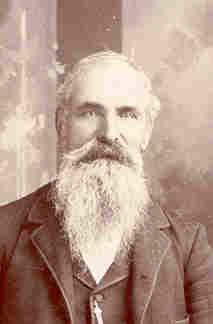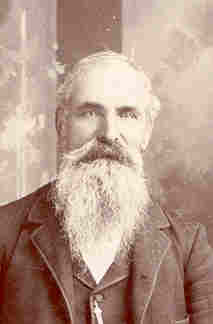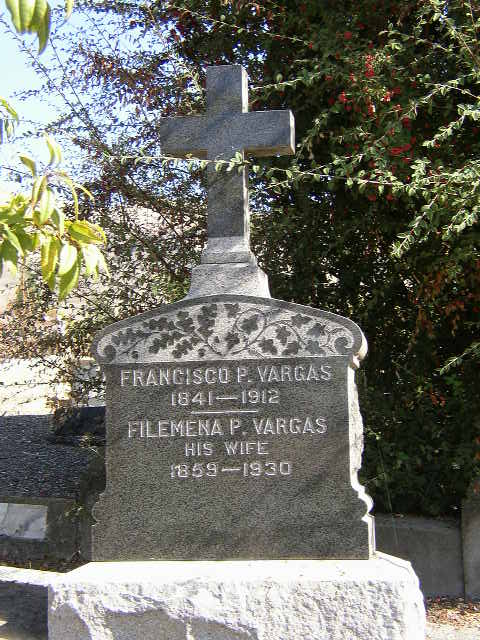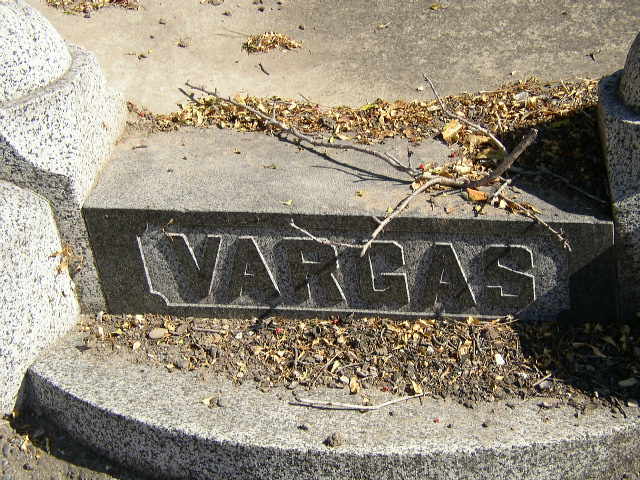Francisco Pereira Vargas (Frank Prada Vargas) was born on July 22, 1840 in Castelo Branco, Faial, to Manuel Pereira de Vargas and Luiza Thomazia Silveira de Freitas. Frank, and his little brother, Antonio Pereira Vargas (born August 19, 1845) grew up without a father, as Manuel went to the United States probably sometime shortly after Antonio’s birth as there were no other children born in that family. About 1860, Frank went to California to work with his father in the gold fields. They story was handed down that the father, Manuel, while working with his son, showed Frank, a picture of a woman and told Frank that she was his mother. Frank said that the image was not of his mother, which enraged the father. Manuel hit his son over the back with a shovel and Frank suffered from back pain throughout his life. Manuel eventually left California and was believed to have gone to Brazil, never to be heard from again.
Frank remained in California and eventually settled in the Warm Springs area, which is now a part of the city of Fremont. Frank share farmed in partnership with Thomas Francisco Pereira who was born in Castelo Branco on August 18, 1849, one of 9 children of Antonio Francisco Pereira and Ermelinda Candida. Thomas' siblings were Jose (1838) who stayed in Faial, Francisca (1842-1915), Antonio (1843-18?), Francisco (1846-1901), Manuel (1848-18?), Serefino (1851- 19?), Christiano (1853-1916), Maria (1856-18?) and Filomena (1859-1930).
Frank and Thomas were among many Portuguese farmers who were given an opportunity to start a new life in California by Mr. Henry Curtner (1830-1917). Mr. Curtner had purchased a large piece of property in 1868 that was part of the original Higuerra grant. The Higuerra grant was part of the former Mission San Jose lands that was given to various Dons, such as the Higuerras and Peraltas, after the secularization of the Missions. Mr. Curtner discovered that the Azorean farmers were adept at hillside farming and recruited laborers from the docks in San Francisco where he hired stranded Portuguese sailors who were unemployed due to poor whaling conditions or who had deserted their ships. Some of his employees were Portuguese farmers who had left the Hawaiian plantations because of low wages. Mr. Curtner provided these laborers with small homes and they, in turn, eventually sent for their families. At one time, there were as many as 72 families living on his property as share croppers.
An entry in a journal dated May 29, 1896, belonging to Frank P. Vargas, states that he made $448.53 in peas and potatoes in 540 sacks and $87.00 in corn in 156 sacks.
Thomas Pereira eventually sent for his sister, Filomena, born February 1, 1859 in Castelo Branco. Filomena was 17 years old when she took out a passport on September 12, 1876, in Faial, for passage on the ship "Modesta" bound for the United States. Filomena often talked about the difficult journey. She said that it took much longer than expected because of high winds at sea. The ship would go one way and then be pushed back. The passengers were put on water rationing and precious rainwater was captured for drinking use. They were running out of food and were all hungry when they arrived in America. It is not known for certain, but there is some thought, in the family, that the journey may have been around the "Horn" of South America. Filomena's was said to have a brother who settled in Brazil and there has been speculation that he might have been on a similar ship’s route to California and was able to get off the ship in South America. Filomena often spoke of her brother, living in Brazil, and expressed sorrow that he had chosen not to come to California.
Though Thomas had sent for his sister, Filomena, her attentions soon turned to his farming partner, Frank Prada Vargas. Frank and Filomena married on October 19, 1878 at St. Joseph's Church in Mission San Jose. Thomas Pereira, was also married that same day to Margaret Flores (daughter of Jose Pimentel Ramos and Maria Carneiro). Thomas and his wife are believed to have settled and raised a family in the Antioch area. Frank and Filomena had nine children who were all born in Warm Springs and baptized at St. Joseph's Church in Mission San Jose. They were Mary, Louise "Lizzie",Frank, Filomena "Minnie", Rosie and Antonio (twins), Ermaline, and Margaret "Maggie".
In 1891, Frank returned to Faial to bring back his mother-in-law, Ermelinda Candida (born December 22, 1820, Castelo Branco to Rita Joaquina and an unrecorded father whose surname may have been Caravalho). Frank ended up bringing several family members back to America: his mother-in-law, Ermelinda, who was a 70 year old widow, and her two adult single children, Francisca and Francisco. Ermelinda's other living children, Serefino and Christiano had immigrated to California at an earlier date. Frank also brought with him a nephew, Manuel Pereira Vargas, aged 9 (born February 9, 1882, Castelo Branco - see his story), the son of Frank's only sibling Antonio, to be raised with his children, in the hope of providing him with a better future than could be had in Faial, This family group arrived on the S.S. Vega in New York harbor on July 13, 1891.
The family of Frank and Filomena Prada came to be known by the appelido "Os Coyotes". Some think that this may have been because they were very fond of eating chicken! Ermelinda, Filomena’s mother, was known to neighbors as “Velha Coyota”. Theirs was a household that bustled with activity. Their home was a gathering place for neighbors to play horseshoes, "4 posts" and card games. Their ranch was near that of Joe Francisco Vargas and Anna Lourenco (see their stories) who also had 10 children. These families often visited back and forth by walking across a field and a creek. Frank and Filomena were also known to be friends of Manuel Silveira Peixoto, a Castelo Branco native who was a founder and first Supreme President of the I.D.E.S. Manuel was godfather to most of their children.
After a life of farming in Warm Springs, Frank Prada Vargas died of croupous pneumonia on March 25, 1912 at the age of 72. His body was laid out in the family home as was the practice in those days. His granddaughter, Erma Vargas Bettencourt, recalled that she had to lean over and kiss him which frightened her, a small child of only five years at the time of her grandfather’s death. Filomena suffered many losses at this time of her life. Her oldest daughter, Mary Sarmento, had died after childbirth on April 11, 1910 and her next daughter, Louise Oliver, died, also in childbirth, on November 30, 1912. Louise left behind 10 living children, including her youngest, Erma, who was raised by an Escobar family.
Filomena eventually went to live with her sister, Francisca, in a home on Prune Avenue in Warm Springs. Her mother, Ermelinda, and her adult single children, had purchased this home when they came to California. Ermelinda died March 29, 1904, and son Francisco died in 1901. Filomena, her single son Frank, and her sister Francisca and Christiano lived together in the home. Francisca died in 1915, followed by Christiano in 1916. Filomena remained in the home with her bachelor son, Frank, but she often left to visit her married daughters, Rosie, Minnie and Maggie.
Filomena taught her daughters and granddaughters to make quilts with left over fabric. Filomena used the span of her hand to mark the areas where she would tie her quilts. They were also fond of making dish towels from flour sacks. Adornments were created on pillowcases and tablecloths by pulling threads on fabric ends, creating a fringe, which, in turn, was knotted into intricate designs. The arts of crochet and tatting were also taught and these skills were used to make doilies, potholders, tablecloths and to decorate pillowcases, towels, slips and nightgowns.
Filomena’s grandchildren recall that she was a very heavy woman, with a very warm, soft and inviting lap. She was soft spoken and would call her little grandchildren in the morning by saying "Vai aqui para sopas da avo." These "sopas" would be warm milk with bread in it. She frequently admonished her grandchildren to "Fala Portugues!" and taught them all to pray in Portuguese. She always wore "widow's black" clothing and a big black rosary at her waist, which she could be often found saying during the day.
Filomena returned to the house on Prune Avenue in 1929, to live with her son, Frank, who married Maria Emilia Vargas (Rodrigues) on October 6, 1929 in Livermore. Maria (born October 19, 1897 in Castelo Branco to Antonio Pereira Vargas and Anna Luiza da Silva) was Frank's first cousin who had been widowed (read about her in Manuel Pereira Vargas story). Filomena lived with her son Frank and his bride only a short time before she died of erysipelas on March 10, 1930.
Frank and Filomena, their daughters Mary Sarmento and Louisa Oliver, Filomena’s mother, Ermelinda, and her children Francisco, Francisca, Christiano and many other family members are buried at St. Joseph's Cemetery on the hill in Mission San Jose.
Copyright Susan Vargas Murphy. All rights reserved.
Francisco Pereira Vargas (Frank Prada Vargas) was born on July 22, 1840 in Castelo Branco, Faial, to Manuel Pereira de Vargas and Luiza Thomazia Silveira de Freitas. Frank, and his little brother, Antonio Pereira Vargas (born August 19, 1845) grew up without a father, as Manuel went to the United States probably sometime shortly after Antonio’s birth as there were no other children born in that family. About 1860, Frank went to California to work with his father in the gold fields. They story was handed down that the father, Manuel, while working with his son, showed Frank, a picture of a woman and told Frank that she was his mother. Frank said that the image was not of his mother, which enraged the father. Manuel hit his son over the back with a shovel and Frank suffered from back pain throughout his life. Manuel eventually left California and was believed to have gone to Brazil, never to be heard from again.
Frank remained in California and eventually settled in the Warm Springs area, which is now a part of the city of Fremont. Frank share farmed in partnership with Thomas Francisco Pereira who was born in Castelo Branco on August 18, 1849, one of 9 children of Antonio Francisco Pereira and Ermelinda Candida. Thomas' siblings were Jose (1838) who stayed in Faial, Francisca (1842-1915), Antonio (1843-18?), Francisco (1846-1901), Manuel (1848-18?), Serefino (1851- 19?), Christiano (1853-1916), Maria (1856-18?) and Filomena (1859-1930).
Frank and Thomas were among many Portuguese farmers who were given an opportunity to start a new life in California by Mr. Henry Curtner (1830-1917). Mr. Curtner had purchased a large piece of property in 1868 that was part of the original Higuerra grant. The Higuerra grant was part of the former Mission San Jose lands that was given to various Dons, such as the Higuerras and Peraltas, after the secularization of the Missions. Mr. Curtner discovered that the Azorean farmers were adept at hillside farming and recruited laborers from the docks in San Francisco where he hired stranded Portuguese sailors who were unemployed due to poor whaling conditions or who had deserted their ships. Some of his employees were Portuguese farmers who had left the Hawaiian plantations because of low wages. Mr. Curtner provided these laborers with small homes and they, in turn, eventually sent for their families. At one time, there were as many as 72 families living on his property as share croppers.
An entry in a journal dated May 29, 1896, belonging to Frank P. Vargas, states that he made $448.53 in peas and potatoes in 540 sacks and $87.00 in corn in 156 sacks.
Thomas Pereira eventually sent for his sister, Filomena, born February 1, 1859 in Castelo Branco. Filomena was 17 years old when she took out a passport on September 12, 1876, in Faial, for passage on the ship "Modesta" bound for the United States. Filomena often talked about the difficult journey. She said that it took much longer than expected because of high winds at sea. The ship would go one way and then be pushed back. The passengers were put on water rationing and precious rainwater was captured for drinking use. They were running out of food and were all hungry when they arrived in America. It is not known for certain, but there is some thought, in the family, that the journey may have been around the "Horn" of South America. Filomena's was said to have a brother who settled in Brazil and there has been speculation that he might have been on a similar ship’s route to California and was able to get off the ship in South America. Filomena often spoke of her brother, living in Brazil, and expressed sorrow that he had chosen not to come to California.
Though Thomas had sent for his sister, Filomena, her attentions soon turned to his farming partner, Frank Prada Vargas. Frank and Filomena married on October 19, 1878 at St. Joseph's Church in Mission San Jose. Thomas Pereira, was also married that same day to Margaret Flores (daughter of Jose Pimentel Ramos and Maria Carneiro). Thomas and his wife are believed to have settled and raised a family in the Antioch area. Frank and Filomena had nine children who were all born in Warm Springs and baptized at St. Joseph's Church in Mission San Jose. They were Mary, Louise "Lizzie",Frank, Filomena "Minnie", Rosie and Antonio (twins), Ermaline, and Margaret "Maggie".
In 1891, Frank returned to Faial to bring back his mother-in-law, Ermelinda Candida (born December 22, 1820, Castelo Branco to Rita Joaquina and an unrecorded father whose surname may have been Caravalho). Frank ended up bringing several family members back to America: his mother-in-law, Ermelinda, who was a 70 year old widow, and her two adult single children, Francisca and Francisco. Ermelinda's other living children, Serefino and Christiano had immigrated to California at an earlier date. Frank also brought with him a nephew, Manuel Pereira Vargas, aged 9 (born February 9, 1882, Castelo Branco - see his story), the son of Frank's only sibling Antonio, to be raised with his children, in the hope of providing him with a better future than could be had in Faial, This family group arrived on the S.S. Vega in New York harbor on July 13, 1891.
The family of Frank and Filomena Prada came to be known by the appelido "Os Coyotes". Some think that this may have been because they were very fond of eating chicken! Ermelinda, Filomena’s mother, was known to neighbors as “Velha Coyota”. Theirs was a household that bustled with activity. Their home was a gathering place for neighbors to play horseshoes, "4 posts" and card games. Their ranch was near that of Joe Francisco Vargas and Anna Lourenco (see their stories) who also had 10 children. These families often visited back and forth by walking across a field and a creek. Frank and Filomena were also known to be friends of Manuel Silveira Peixoto, a Castelo Branco native who was a founder and first Supreme President of the I.D.E.S. Manuel was godfather to most of their children.
After a life of farming in Warm Springs, Frank Prada Vargas died of croupous pneumonia on March 25, 1912 at the age of 72. His body was laid out in the family home as was the practice in those days. His granddaughter, Erma Vargas Bettencourt, recalled that she had to lean over and kiss him which frightened her, a small child of only five years at the time of her grandfather’s death. Filomena suffered many losses at this time of her life. Her oldest daughter, Mary Sarmento, had died after childbirth on April 11, 1910 and her next daughter, Louise Oliver, died, also in childbirth, on November 30, 1912. Louise left behind 10 living children, including her youngest, Erma, who was raised by an Escobar family.
Filomena eventually went to live with her sister, Francisca, in a home on Prune Avenue in Warm Springs. Her mother, Ermelinda, and her adult single children, had purchased this home when they came to California. Ermelinda died March 29, 1904, and son Francisco died in 1901. Filomena, her single son Frank, and her sister Francisca and Christiano lived together in the home. Francisca died in 1915, followed by Christiano in 1916. Filomena remained in the home with her bachelor son, Frank, but she often left to visit her married daughters, Rosie, Minnie and Maggie.
Filomena taught her daughters and granddaughters to make quilts with left over fabric. Filomena used the span of her hand to mark the areas where she would tie her quilts. They were also fond of making dish towels from flour sacks. Adornments were created on pillowcases and tablecloths by pulling threads on fabric ends, creating a fringe, which, in turn, was knotted into intricate designs. The arts of crochet and tatting were also taught and these skills were used to make doilies, potholders, tablecloths and to decorate pillowcases, towels, slips and nightgowns.
Filomena’s grandchildren recall that she was a very heavy woman, with a very warm, soft and inviting lap. She was soft spoken and would call her little grandchildren in the morning by saying "Vai aqui para sopas da avo." These "sopas" would be warm milk with bread in it. She frequently admonished her grandchildren to "Fala Portugues!" and taught them all to pray in Portuguese. She always wore "widow's black" clothing and a big black rosary at her waist, which she could be often found saying during the day.
Filomena returned to the house on Prune Avenue in 1929, to live with her son, Frank, who married Maria Emilia Vargas (Rodrigues) on October 6, 1929 in Livermore. Maria (born October 19, 1897 in Castelo Branco to Antonio Pereira Vargas and Anna Luiza da Silva) was Frank's first cousin who had been widowed (read about her in Manuel Pereira Vargas story). Filomena lived with her son Frank and his bride only a short time before she died of erysipelas on March 10, 1930.
Frank and Filomena, their daughters Mary Sarmento and Louisa Oliver, Filomena’s mother, Ermelinda, and her children Francisco, Francisca, Christiano and many other family members are buried at St. Joseph's Cemetery on the hill in Mission San Jose.
Copyright Susan Vargas Murphy. All rights reserved.
Inscription
Francisco P. Vargas
1841 - 1912
Gravesite Details
1841 date is an error...really born in 1840.












